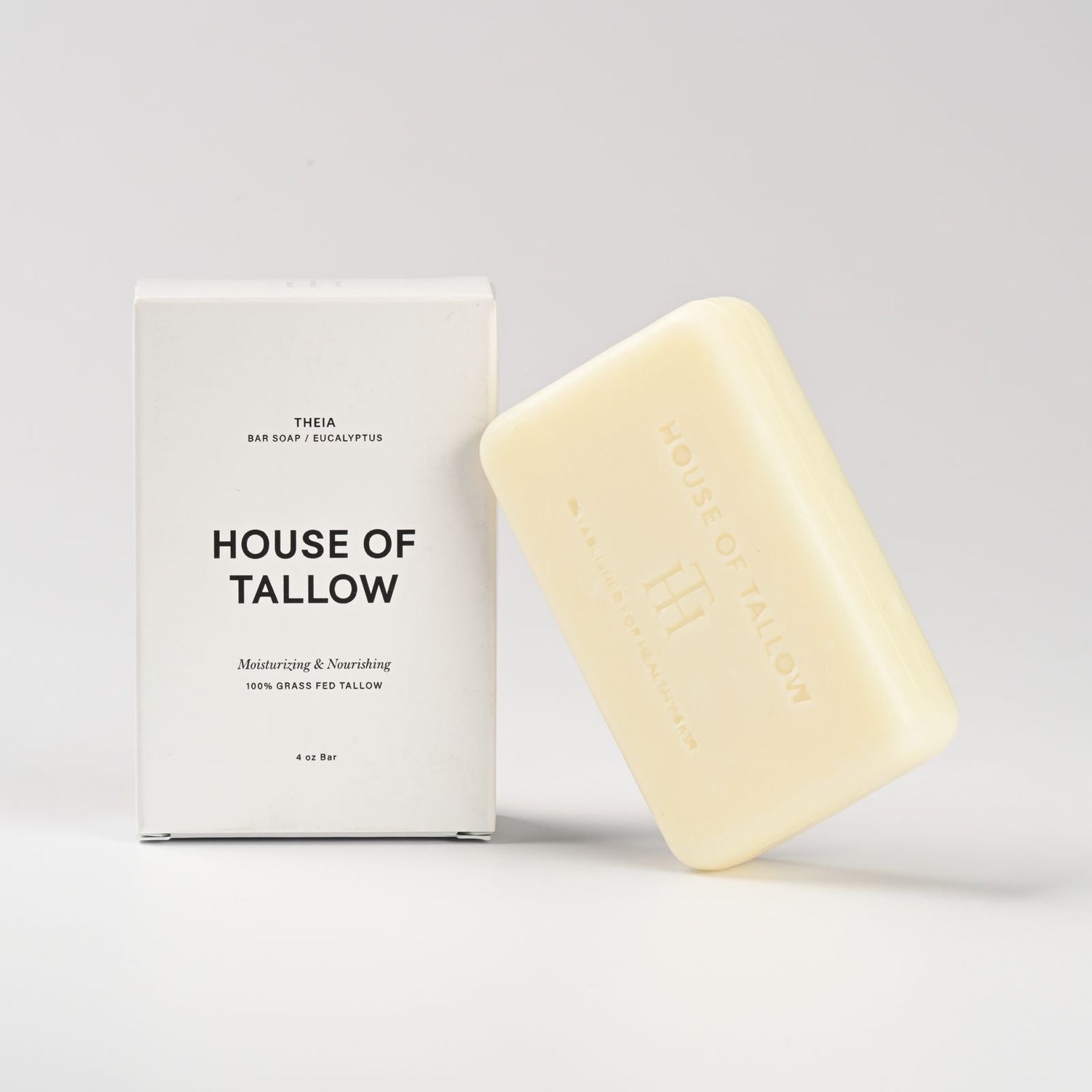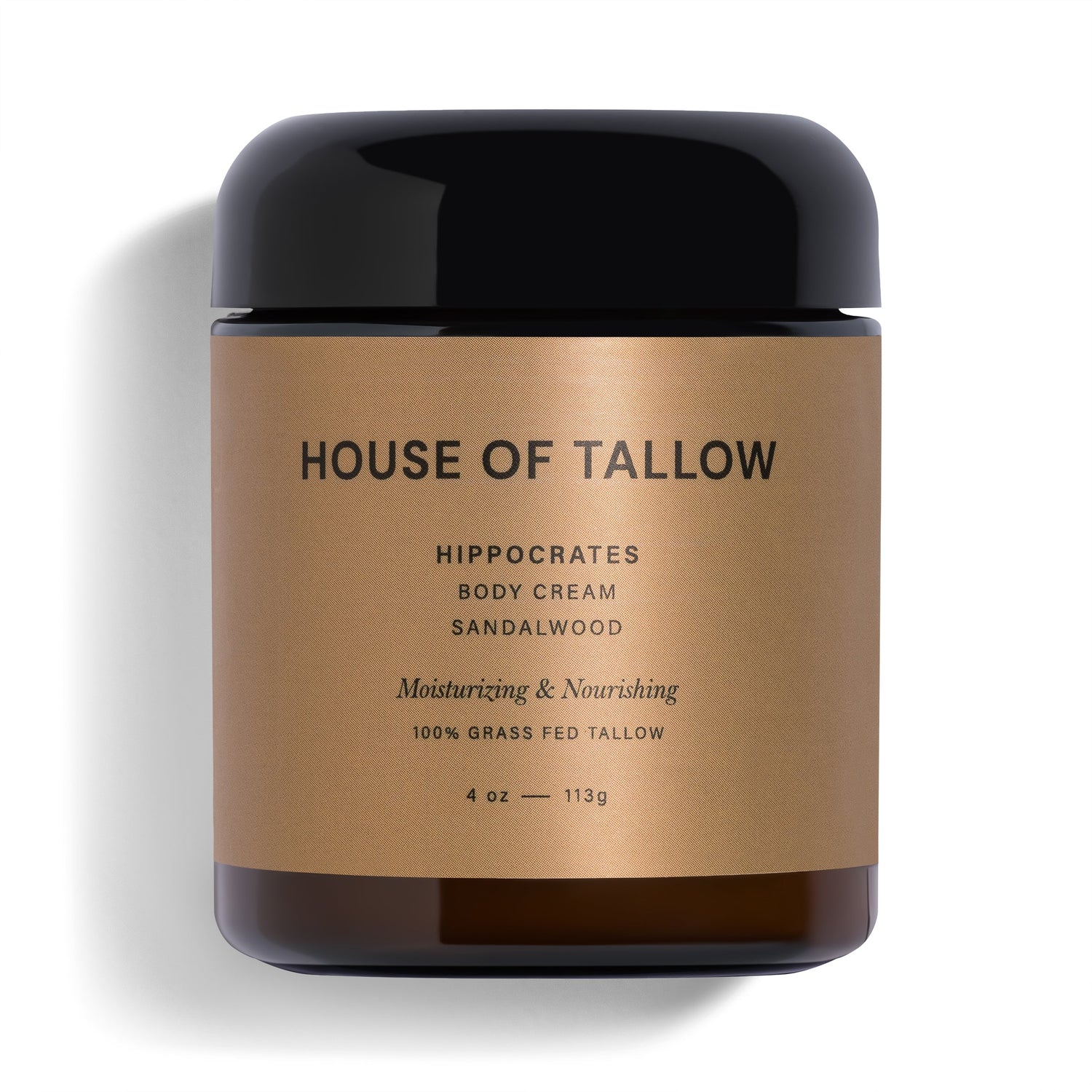Struggling to decide between tallow and hyaluronic acid for your skincare routine? Here’s a quick breakdown:
- Tallow: Derived from animal fat, it creates a protective barrier, locks in moisture, and is rich in vitamins A, D, E, and K. Best for dry or eczema-prone skin, but can clog pores for oily or acne-prone types.
- Hyaluronic Acid (HA): A humectant that attracts water to the skin, hydrating without clogging pores. Suitable for most skin types, especially oily, sensitive, or acne-prone. Works best when paired with a moisturizer.
Quick Comparison
| Characteristic | Tallow | Hyaluronic Acid |
|---|---|---|
| Source | Animal-derived (grass-fed cows) | Body-made or lab-created |
| Primary Function | Forms a protective barrier | Attracts and retains water |
| Best For | Dry, eczema-prone skin | Most skin types (sensitive, oily) |
| Moisture Approach | Seals in moisture | Needs a moisturizer to lock in |
| Potential Issues | Can clog pores for oily skin | May dry skin if not sealed properly |
Both ingredients offer unique benefits. Tallow strengthens the skin barrier and provides deep nourishment, while hyaluronic acid delivers lightweight hydration. Your choice depends on your skin type and hydration needs.
Origins and Makeup
Tallow: From Grass-Fed Animals
Tallow is derived from cattle fat, primarily from grass-fed animals . House of Tallow ensures its tallow comes exclusively from grass-fed cattle, focusing on its benefits for skincare.
Grass-fed tallow is packed with nutrients thanks to the animals' natural diet and access to open pastures. It contains fat-soluble vitamins A, D, E, and K, along with fatty acids that boast an Omega-6 to Omega-3 ratio of about 1.4:1 . It also includes natural compounds that closely resemble those found in human skin. Now, let’s take a closer look at hyaluronic acid and how it’s produced.
Hyaluronic Acid: Naturally Occurring and Lab-Made
Hyaluronic acid (HA) is a substance your body naturally produces, found in areas like the eyes, joints, and skin. However, its production decreases by around 6% every decade .
In skincare, HA is created through biofermentation. Here’s a breakdown of some key production methods:
| Company | Production Method | Features |
|---|---|---|
| DSM | Sugar fermentation | Vegan-friendly; introduced in March 2021 |
| Contipro | Bacterial culture | Uses streptococci fermentation for reliable quality |
| Neutrogena | Multiple molecular weights | Offers HA between 50–1,700 kDa for diverse skin absorption |
Lab-created HA ensures consistent quality and allows for tailored molecular weights, catering to the growing preference for vegan-friendly ingredients.
"With the growing demand for vegan beauty products, synthetic and fermented ingredients have become a very attractive product to use and make new marketing claims around." - Volker Rosenberger, marketing manager for skin care at DSM
How They Moisturize
Tallow: Forms a Moisture Barrier
Tallow helps hydrate the skin by creating a barrier with fatty acids like oleic, palmitic, stearic, and linoleic acids, which closely resemble the skin's natural oils . Dr. Elizabeth Bahar Houshmand, MD, FAAD, explains:
"Beef tallow can potentially help dry skin as a moisturizer. It is rich in fatty acids, including oleic, palmitic, stearic, and linoleic acid, which can form a protective shield that seals in moisture to help the skin barrier" .
However, tallow isn't ideal for everyone. It can clog pores, especially for those with oily or acne-prone skin. Dr. Corey L. Hartman warns:
"Beef tallow is comedogenic, which means it can clog pores. I recommend that patients with oily, acne-prone skin stay away from beef tallow to avoid increasing breakouts" .
While tallow locks in moisture with a barrier, another ingredient works by pulling water into the skin.
Hyaluronic Acid: Attracts and Retains Water
Hyaluronic acid is a humectant, meaning it draws water to the skin and helps it stay hydrated. Just a quarter-teaspoon of HA can hold about 1.5 gallons of water . Lilith Hardie Lupica from Go-To Skin Care describes its action:
"As hyaluronic acid is a humectant, it's essentially a moisture magnet, which means it draws moisture to itself rather indiscriminately, helping bind it to your skin and prevent transepidermal water loss (TEWL)" .
For best results, apply hyaluronic acid to damp skin and follow with a moisturizer or oil to lock in the hydration. If not sealed properly - especially in dry environments - HA can pull moisture from deeper skin layers, potentially leading to dryness .
Key tips for using hyaluronic acid:
| Application Factor | Recommendation | Why It Matters |
|---|---|---|
| Skin Condition | Apply to damp skin | Prevents HA from pulling moisture from deeper layers of skin |
| Follow-up Product | Use a moisturizer or oil | Locks in the hydration HA attracts |
| Environment | Check humidity levels | HA works best in environments with adequate moisture |
Both tallow and hyaluronic acid can address hydration needs, but their effectiveness depends on how they're used and individual skin types. Proper application is crucial to maximize their benefits.
Tallow Skin Care: Routines for Different Skin Types
sbb-itb-a1b9fc0
Skin Barrier Effects
For sensitive skin, maintaining a healthy barrier is key to reducing irritation and preventing moisture loss.
Tallow's Role in Supporting the Skin Barrier
Tallow helps reinforce the skin barrier by closely mimicking its natural lipid structure. Its composition aligns with the skin's own lipids, making it effective at strengthening and repairing the protective layer. Dr. Anil Sharma, a dermatologist with Sharma Skin & Hair Surgery, notes:
"Due to its make-up, beef tallow closely mimics the skin's natural oils. Its natural and lipid-rich composition can make it an effective moisturizer and healing agent for those with eczema-prone or extremely dry skin."
The skin's protective barrier is built from specific lipid ratios: 45-50% ceramides, 20-25% cholesterol, and 10-15% free fatty acids . Tallow's composition mirrors these proportions, making it especially helpful for strengthening the barrier.
| Tallow Benefits | How It Works |
|---|---|
| Vitamin Support | Packed with vitamins A, D, E, and K, which aid skin regeneration and combat oxidative stress |
| Calms Irritation | Fatty acids naturally soothe and reduce inflammation |
| Barrier Integration | Blends seamlessly with the skin's lipid structure |
On the other hand, hyaluronic acid (HA) takes a different approach, offering hydration without directly reinforcing the barrier.
Hyaluronic Acid's Hydrating Approach
Hyaluronic acid works by hydrating the skin from within, helping it retain moisture without creating a heavy barrier. It doesn't replicate the skin's lipids but instead supports hydration through its water-binding properties.
The main difference between the two lies in how they interact with damaged skin barriers. Tallow actively repairs and strengthens the barrier with its lipid-rich makeup, while hyaluronic acid provides gentle hydration without disrupting the skin's natural repair process.
When deciding between these ingredients for barrier support, consider your skin's specific needs:
| Skin Condition | Best Choice | Why |
|---|---|---|
| Compromised Barrier | Tallow | Repairs the barrier with lipid-rich support |
| Dehydrated but Healthy | Hyaluronic Acid | Hydrates without adding weight |
| Highly Sensitive | Start with HA | Gentle and less likely to irritate |
| Eczema-Prone | Tallow (with caution) | Test small amounts to check for tolerance |
A 2017 study found that tallow-based treatments enhanced skin hydration in women with dry and sensitive skin , highlighting its effectiveness for repairing compromised barriers.
Results Over Time
Both tallow and hyaluronic acid provide distinct long-term effects, thanks to their moisturizing properties and ability to support the skin’s barrier.
Tallow's Long-Term Impact
Using tallow-based products over time helps maintain hydration and supports the skin’s natural barrier. Its nutrient-rich composition aids skin regeneration, and its fatty acids closely resemble the skin's natural oils, helping to seal in moisture . That said, differences in product formulations and a lack of extensive clinical studies can lead to varying results .
Hyaluronic Acid's Lasting Effects
Research shows that cross-linked hyaluronic acid (CL-HA) injections in participants over 60 with photoaged skin activated fibroblasts and boosted type I collagen production within just one week. These effects lasted for 6–9 months . By four weeks, thick collagen bundles were observed around CL-HA pools, and significant collagen levels were still present 12 months later. Additional studies highlight that resilient hyaluronic acid (RHA) reduces transepidermal water loss (TEWL) by 27.8% and increases epidermal water content by 7.6%. Meanwhile, high-molecular-weight HA reduced TEWL by 15.6%, but low-molecular-weight HA caused a 55.5% increase in TEWL .
Hyaluronic acid’s ability to stimulate type I collagen production leads to lasting improvements in hydration and skin structure . While both tallow and hyaluronic acid provide long-term benefits, hyaluronic acid tends to deliver more consistent results in clinical settings. For those with sensitive skin, its reliable hydration and structural improvements make it an appealing choice.
Making Your Choice
Skin Type Considerations
The right choice between tallow and hyaluronic acid depends on your skin type and specific concerns. Experts suggest tallow works well for dry skin, while hyaluronic acid is better suited for acne-prone or sensitive skin .
Tallow is great for dry skin because it forms a protective barrier that locks in moisture. On the other hand, hyaluronic acid hydrates effectively without clogging pores, making it a safer option for oily, acne-prone, or sensitive skin .
| Skin Type | Best Choice | Why It Works |
|---|---|---|
| Dry | Tallow | Creates a moisture barrier; packed with vitamins A, D, E, and K |
| Oily/Acne-Prone | Hyaluronic Acid | Lightweight hydration that won’t block pores |
| Combination | Hyaluronic Acid | Hydrates without triggering breakouts |
| Sensitive | Hyaluronic Acid | Gentle and suitable for reactive skin |
When deciding, it’s not just about skin performance - consider the environmental impact of each ingredient too.
Eco-Friendly Options
Tallow, when responsibly sourced, supports sustainability by repurposing animal byproducts that might otherwise go to waste. Brands like House of Tallow highlight this approach by focusing on grass-fed tallow and prioritizing ethical practices.
"From our ethos to our manufacturing process and sustainable business ethic - we make sure that House of Tallow is a sustainable and ethical brand." - House of Tallow
For eco-conscious choices, look for grass-fed tallow products. If you’re in a dry climate and using hyaluronic acid, pair it with a moisturizer to help seal in hydration .




